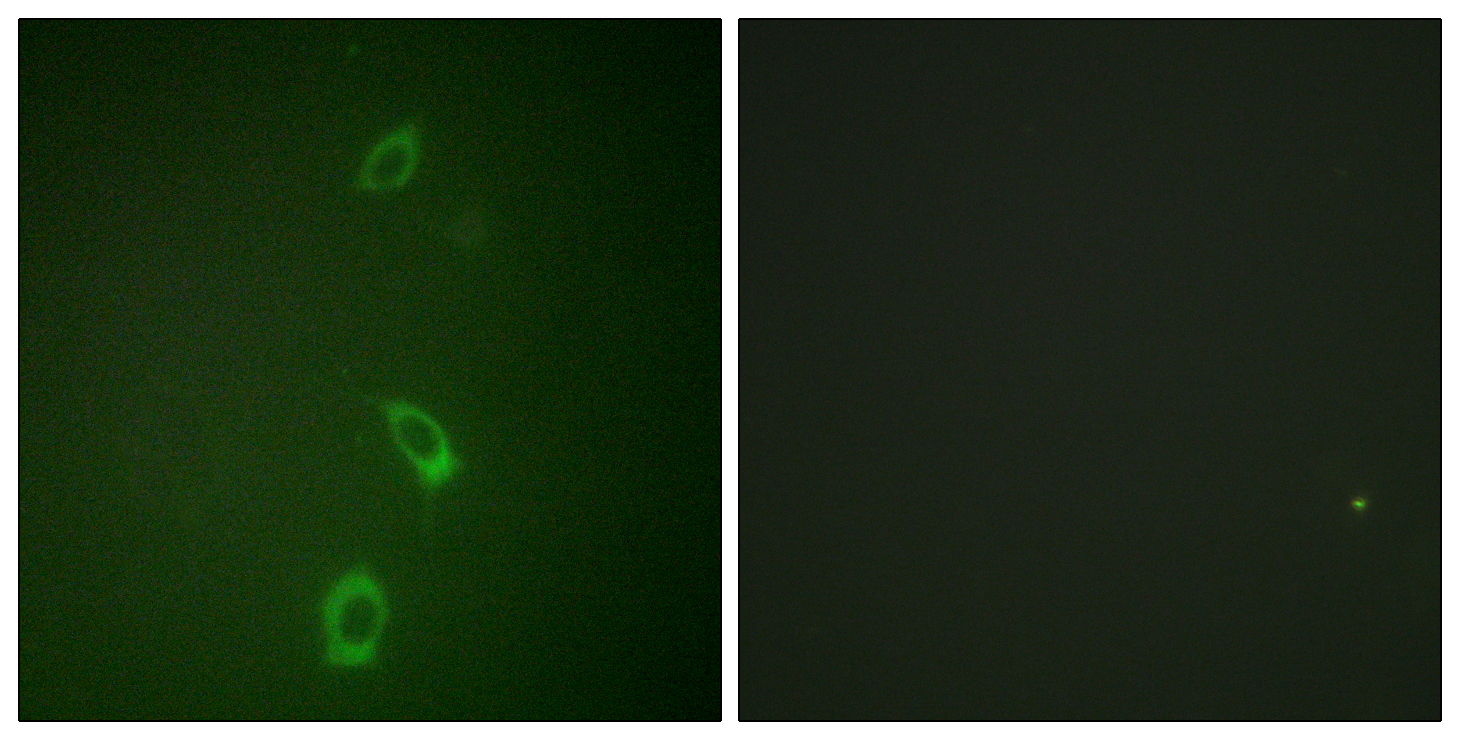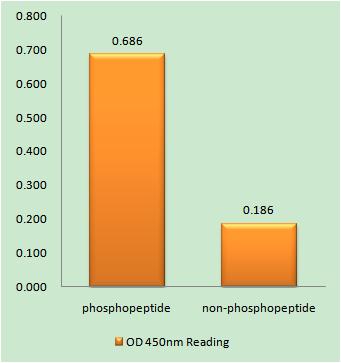
Catalog: YP1160
Size
Price
Status
Qty.
200μL
$600.00
In stock
0
100μL
$340.00
In stock
0
50μL
$190.00
In stock
0
Add to cart


Collected


Collect
Main Information
Target
ROM-K
Host Species
Rabbit
Reactivity
Human, Mouse, Rat
Applications
IHC, IF, ELISA
MW
45kD (Calculated)
Conjugate/Modification
Phospho
Detailed Information
Recommended Dilution Ratio
IHC 1:100-1:300; IF 1:200-1:1000; ELISA 1:5000; Not yet tested in other applications.
Formulation
Liquid in PBS containing 50% glycerol, 0.5% BSA and 0.02% sodium azide.
Specificity
Phospho-ROM-K (S44) Polyclonal Antibody detects endogenous levels of ROM-K protein only when phosphorylated at S44.The name of modified sites may be influenced by many factors, such as species (the modified site was not originally found in human samples) and the change of protein sequence (the previous protein sequence is incomplete, and the protein sequence may be prolonged with the development of protein sequencing technology). When naming, we will use the "numbers" in historical reference to keep the sites consistent with the reports. The antibody binds to the following modification sequence (lowercase letters are modification sites):LVsKD
Purification
The antibody was affinity-purified from rabbit antiserum by affinity-chromatography using epitope-specific immunogen.
Storage
-15°C to -25°C/1 year(Do not lower than -25°C)
Concentration
1 mg/ml
MW(Calculated)
45kD
Modification
Phospho
Clonality
Polyclonal
Isotype
IgG
Related Products
Antigen&Target Information
Immunogen:
The antiserum was produced against synthesized peptide derived from human ROMK/Kir1.1 around the phosphorylation site of Ser44/25. AA range:11-60
show all
Specificity:
Phospho-ROM-K (S44) Polyclonal Antibody detects endogenous levels of ROM-K protein only when phosphorylated at S44.The name of modified sites may be influenced by many factors, such as species (the modified site was not originally found in human samples) and the change of protein sequence (the previous protein sequence is incomplete, and the protein sequence may be prolonged with the development of protein sequencing technology). When naming, we will use the "numbers" in historical reference to keep the sites consistent with the reports. The antibody binds to the following modification sequence (lowercase letters are modification sites):LVsKD
show all
Gene Name:
KCNJ1
show all
Protein Name:
ATP-sensitive inward rectifier potassium channel 1
show all
Other Name:
KCNJ1 ;
ROMK1 ;
ATP-sensitive inward rectifier potassium channel 1 ;
ATP-regulated potassium channel ROM-K ;
Inward rectifier K ;
+ ;
channel Kir1.1 ;
Potassium channel ;
inwardly rectifying subfamily J member 1
ROMK1 ;
ATP-sensitive inward rectifier potassium channel 1 ;
ATP-regulated potassium channel ROM-K ;
Inward rectifier K ;
+ ;
channel Kir1.1 ;
Potassium channel ;
inwardly rectifying subfamily J member 1
show all
Database Link:
Background:
Potassium channels are present in most mammalian cells, where they participate in a wide range of physiologic responses. The protein encoded by this gene is an integral membrane protein and inward-rectifier type potassium channel. It is activated by internal ATP and probably plays an important role in potassium homeostasis. The encoded protein has a greater tendency to allow potassium to flow into a cell rather than out of a cell. Mutations in this gene have been associated with antenatal Bartter syndrome, which is characterized by salt wasting, hypokalemic alkalosis, hypercalciuria, and low blood pressure. Multiple transcript variants encoding different isoforms have been found for this gene. [provided by RefSeq, Jul 2008],
show all
Function:
Disease:Defects in KCNJ1 are the cause of Bartter syndrome type 2 (BS2) [MIM:241200]; also termed hyperprostanglandin E syndrome 2. BS refers to a group of autosomal recessive disorders characterized by impaired salt reabsorption in the thick ascending loop of Henle with pronounced salt wasting, hypokalemic metabolic alkalosis, and varying degrees of hypercalciuria. BS2 is a life-threatening condition beginning in utero, with marked fetal polyuria that leads to polyhydramnios and premature delivery. Another hallmark of BS2 is a marked hypercalciuria and, as a secondary consequence, the development of nephrocalcinosis and osteopenia.,Function:In the kidney, probably plays a major role in potassium homeostasis. Inward rectifier potassium channels are characterized by a greater tendency to allow potassium to flow into the cell rather than out of it. Their voltage dependence is regulated by the concentration of extracellular potassium; as external potassium is raised, the voltage range of the channel opening shifts to more positive voltages. The inward rectification is mainly due to the blockage of outward current by internal magnesium. This channel is activated by internal ATP and can be blocked by external barium.,similarity:Belongs to the inward rectifier-type potassium channel family.,tissue specificity:In the kidney and pancreatic islets. Lower levels in skeletal muscle, pancreas, spleen, brain, heart and liver.,
show all
Cellular Localization:
Cell membrane ; Multi-pass membrane protein . Phosphorylation at Ser-44 by SGK1 is necessary for its expression at the cell membrane. .
show all
Tissue Expression:
In the kidney and pancreatic islets. Lower levels in skeletal muscle, pancreas, spleen, brain, heart and liver.
show all
Research Areas:
>>Aldosterone-regulated sodium reabsorption ;
>>Gastric acid secretion
>>Gastric acid secretion
show all
Reference Citation({{totalcount}})
Catalog: YP1160
Size
Price
Status
Qty.
200μL
$600.00
In stock
0
100μL
$340.00
In stock
0
50μL
$190.00
In stock
0
Add to cart


Collected


Collect
Recently Viewed Products
Clear allPRODUCTS
CUSTOMIZED
ABOUT US
Toggle night Mode
{{pinfoXq.title || ''}}
Catalog: {{pinfoXq.catalog || ''}}
Filter:
All
{{item.name}}
{{pinfo.title}}
-{{pinfo.catalog}}
Main Information
Target
{{pinfo.target}}
Reactivity
{{pinfo.react}}
Applications
{{pinfo.applicat}}
Conjugate/Modification
{{pinfo.coupling}}/{{pinfo.modific}}
MW (kDa)
{{pinfo.mwcalc}}
Host Species
{{pinfo.hostspec}}
Isotype
{{pinfo.isotype}}
Product {{index}}/{{pcount}}
Prev
Next
{{pvTitle}}
Scroll wheel zooms the picture
{{pvDescr}}




















